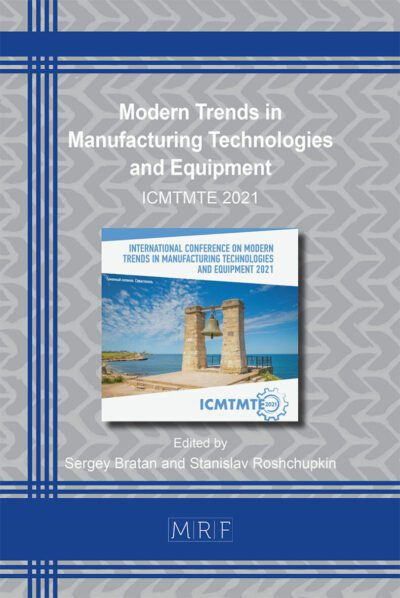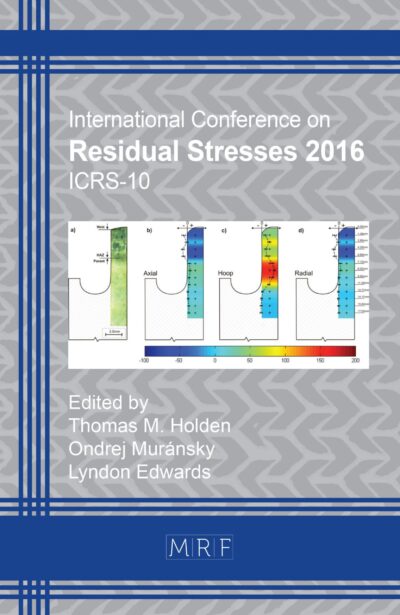Investigation of post-processing of additively manufactured stainless steel by electrochemical jet machining
Philipp DAMM, Daniel GROSCHUPP, Lars BERG, Alexander THIELECKE, Gunnar MEICHSNER, Matthias HACKERT-OSCHÄTZCHEN
Abstract. Additively manufactured components enable the flexible design of parts with customised features. Consequently, additive manufacturing already has a high degree of industrial application. A limiting factor of this technology is the high surface roughness that results from layer-to-layer processing, such as staircase effect, spatters and balling effect. A possibility for the post-processing of additively manufactured components is Jet-ECM. By applying Jet-ECM, additively manufactured components can be selectively finished and microstructured. The material is removed in an electrolyte jet that is moved laterally across the workpiece. Due to the anodic metal dissolution, metals can be processed regardless of their mechanical properties. Based on the results, it was determined that the roughness can be reduced with increased nozzle velocity. In addition, the removal depth can be achieved with a higher number of traversing frequency or with a decreasing nozzle velocity.
Keywords
Electrochemical Jet Machining, Additive Manufacturing, Post-Processing
Published online 5/7/2025, 8 pages
Copyright © 2025 by the author(s)
Published under license by Materials Research Forum LLC., Millersville PA, USA
Citation: Philipp DAMM, Daniel GROSCHUPP, Lars BERG, Alexander THIELECKE, Gunnar MEICHSNER, Matthias HACKERT-OSCHÄTZCHEN, Investigation of post-processing of additively manufactured stainless steel by electrochemical jet machining, Materials Research Proceedings, Vol. 54, pp 2256-2263, 2025
DOI: https://doi.org/10.21741/9781644903599-243
The article was published as article 243 of the book Material Forming
![]() Content from this work may be used under the terms of the Creative Commons Attribution 3.0 license. Any further distribution of this work must maintain attribution to the author(s) and the title of the work, journal citation and DOI.
Content from this work may be used under the terms of the Creative Commons Attribution 3.0 license. Any further distribution of this work must maintain attribution to the author(s) and the title of the work, journal citation and DOI.
References
[1] A. W. Hashmi, H. S. Mali, A. Meena, S. Ahmad, A. P. V. Puerta, and M. E. Kunkel, A critical review of mechanical-based post-processing techniques for additively manufactured parts, in: Z. Alam, F. Iqbal, and D. A. Khan, (Eds.), Post-processing Techniques for Additive Manufacturing, CRC Press, Boca Raton, 2023, pp. 99–127. doi.org/10.1201/9781003288619-5
[2] M. Y. Zanjani, A. Martin, A. S. Mike Zinecker, Statistical Analysis of Jet Electrochemical Post-processing of Additively Manufactured Workpieces, INSECT (2020), 77–84
[3] A. Speidel, R. Sélo, I. Bisterov, J. Mitchell-Smith, and A. T. Clare, Post processing of additively manufactured parts using electrochemical jet machining, Mater. Lett. 292 (2021) 129671, doi.org/10.1016/j.matlet.2021.129671
[4] W. Natsu, T. Ikeda, and M. Kunieda, Generating complicated surface with electrolyte jet machining, Prec. Eng. 31 (2007) 33–39, doi.org/10.1016/j.precisioneng.2006.02.004.
[5] M. Hackert-Oschätzchen, G. Meichsner, M. Zinecker, A. Martin, and A. Schubert, Micro machining with continuous electrolytic free jet, Prec. Eng. 36 (2012) 612–619, doi.org/10.1016/j.precisioneng.2012.05.003.
[6] M. Hackert, G. Meichsner, and A. Schubert, Generating micro geometries with air assisted jet electrochemical machining, Proceedings of the euspen 10th Anniversary International Conference (2008), doi.org/10.24406/publica-fhg-358083.














